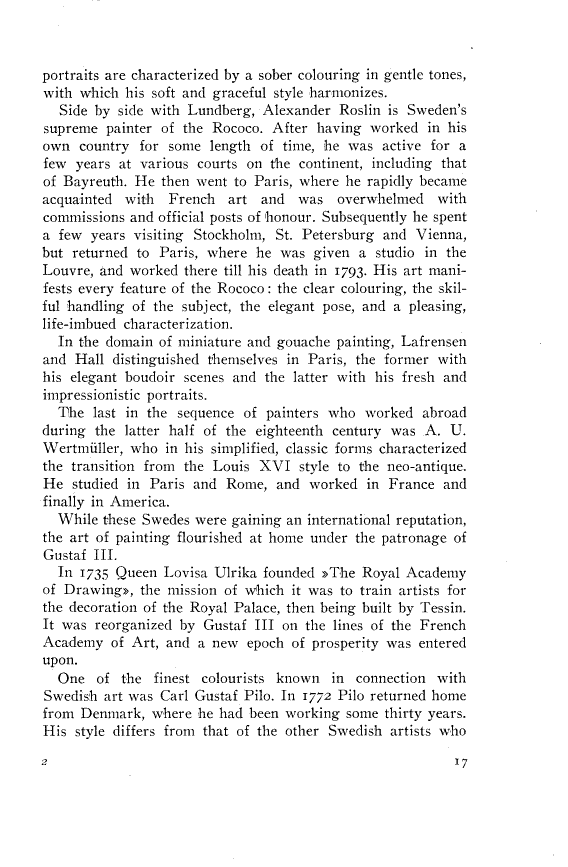
Full resolution (TIFF) - On this page / på denna sida - A short survey of the development of Swedish painting

<< prev. page << föreg. sida << >> nästa sida >> next page >>
Below is the raw OCR text
from the above scanned image.
Do you see an error? Proofread the page now!
Här nedan syns maskintolkade texten från faksimilbilden ovan.
Ser du något fel? Korrekturläs sidan nu!
This page has never been proofread. / Denna sida har aldrig korrekturlästs.
portraits are characterized by a sober colouring in gentle tones,
with which his soft and graceful style harmonizes.
Side by side with Lundberg, Alexander Roslin is Sweden’s
supreme painter of the Rococo. After having worked in his
own country for some length of time, he was active for a
few years at various courts on the continent, including that
of Bayreuth. He then went to Paris, where he rapidly became
acquainted with French art and was overwhelmed with
commissions and official posts of honour. Subsequently he spent
a few years visiting Stockholm, St. Petersburg and Vienna,
but returned to Paris, where he was given a studio in the
Louvre, and worked there till his death in 1793. His art
manifests every feature of the Rococo : the clear colouring, the
skilful handling of the subject, the elegant pose, and a pleasing,
life-imbued characterization.
In the domain of miniature and gouache painting, Lafrensen
and Hall distinguished themselves in Paris, the former with
his elegant boudoir scenes and the latter with his fresh and
impressionistic portraits.
The last in the sequence of painters who worked abroad
during the latter half of the eighteenth century was A. U.
Wertmüller, who in his simplified, classic forms characterized
the transition from the Louis XVI style to the neo-antique.
He studied in Paris and Rome, and worked in France and
finally in America.
While these Swedes were gaining an international reputation,
the art of painting flourished at home under the patronage of
Gustaf III.
In 1735 Queen Lovisa Ulrika founded »The Royal Academy
of Drawing», the mission of which it was to train artists for
the decoration of the Royal Palace, then being built by Tessin.
It was reorganized by Gustaf III on the lines of the French
Academy of Art, and a new epoch of prosperity was entered
upon.
One of the finest colourists known in connection with
Swedish art was Carl Gustaf Pilo. In 1772 Pilo returned home
from Denmark, where he had been working some thirty years.
His style differs from that of the other Swedish artists wrho
17
<< prev. page << föreg. sida << >> nästa sida >> next page >>